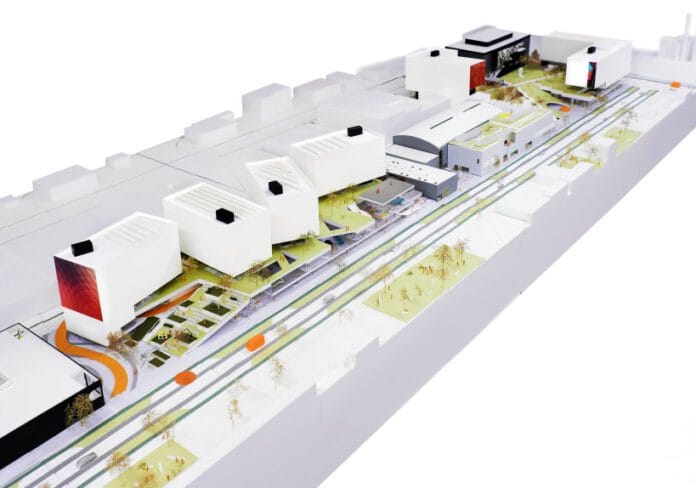
The physical model of ArtCenter’s South Campus master plan revealed to the local community November 12, 2015. (Courtesy of Michael Maltzan Architecture)
A bit on the, well, seasoned side, I don’t spend a lot of time worrying about what AI will mean to me and my writing and editing career. I won’t be in the journalistic trenches for the worst of it.
But I do realize that mean is the operative word here.
If I were a young person, however, I would be running from, and trying to undermine, the robots as fast and hard as a musician should be trying to smash Spotify.
And I’m thrilled to see that one young local artist, Karla Ortiz, is doing precisely that to counter the dangers of artificial intelligence.
She is the first artist to paint a picture overlaid by a new computer program, Glaze, that was integrated into her painting and any reproduced image of her — and presumably others’ — painting so that when AI tries to understand its style, copy it, produce another painting “in the manner of,” it ends up with gobbledygook, and has to move on to the next creative sucker’s work to do its dirty deeds, dirt cheap.
This is insurrection! It’s rage against the machine! An analog subterfuge of the digital dictatorship!
And for me it’s breaking news that I just read about in a new publication from Pasadena’s ArtCenter College of Design, ArtCenter On, which ArtCenter President Karen Hoffman says is designed “to highlight the important discussions taking place both in our classrooms and in the world at large.”
In the small magazine, we find out in an article “Adapt or Die” by Mike R. Winder that while most of us have only been fixated by what AI means to our future over the last year or so since the widespread availability of ChatGPT and other such programs, ArtCenter’s Interaction Design Chair Todd Masilko and Professor Jenny Rodenhouse have been teaching a class called AI and Agents at the school for seven years now. Winder writes: “Generative AI is poised to alter the creative landscape forever. What does its arrival mean for artists and designers?”
The painting that Ortiz created this year overlaid by Glaze, “Musa Victoriosa,” shows a young woman in a kind of Greek gown holding up a laurel wreath surrounded by eagles against a sunset sky. It’s gorgeous. And presumably if I were a ravenous program gobbling up all the art in the world, cataloging it and then helpfully responding when you asked it “Create me a beautiful painting in the style of Karla Ortiz,” you’d be out of luck, babe. Maybe even if I took a picture of it here on my desk with my phone and tried to text it to you.
And the young artist is not just breaking ground, graphically. From the story: “In January of this year, artists Sarah Andersen, Kelly McKenran and Karla Ortiz filed a class-action lawsuit against Stable Diffusion, Midjourney and DeviantArt, calling those companies’ AI image generators ‘21st century collage tools that violate the rights of millions of artists.’ The suit calls out how users of those programs enter into their prompts the words ‘in the style of’ followed by a specific artist’s name, in order to convincingly produce art in that artist’s style.”
One problem they face: In the United States, unlike in some other countries, artistic style as opposed to an actual individual work is not protected by copyright or anything like it.
Which has been good, for freedom of expression and for the ability, for instance, to parody art and writing without legal pushback.
But AI and its stealing evils is not that. It’s way more dangerous to the ability of artists just coming up to have a future in which they can make a living without being robot-robbed.
The story quotes Ben Zhao, a professor of computer science at the University of Chicago, who with his graduate students developed Glaze to help artists protect their work. “This is a really critical time right now,” Zhao says. “In the next few months, we could see dramatic changes for the future.”
“As Zhao explains it, when an artwork is processed through Glaze, the effects it adds to the image have a minimal impact on how humans perceive the work. But if AI tries to use that same image to learn and reproduce the artist’s style, it faces a number of distortion barriers, and it can even be tricked into creating a work in a completely different style (cubism, for example). ‘The Glaze effects are robust and can’t be circumvented,’ says Zhao. ‘They are computed on a pixel level so they’re fully integrated with the image.’”
Down with the droids! Up with people! Or, I don’t know, this could at least push the singularity back by a few months or so.
Write the public editor at lwilson@scng.com.









